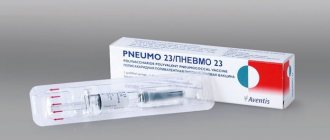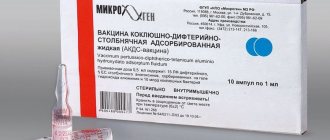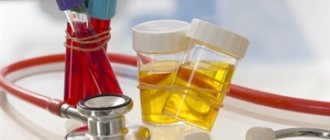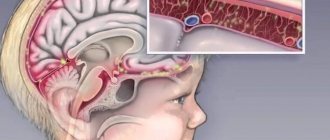Infanrix Gexa - Vaccine for the prevention of diphtheria, tetanus, whooping cough (acellular), polio (inactivated), hepatitis B combined, adsorbed in combination with a vaccine for the prevention of infection caused by Haemophilus influenzae type b conjugated, adsorbed Registration number: LP 000877 Trade name: Infanrix Gexa Group name: Infanrix Hexa Dosage form: Suspension for intramuscular administration complete with lyophilisate for preparing a suspension for intramuscular administration. Country of origin: GlaxoSmithKline Biologicals, Belgium Preliminary examination: Not required Vaccine cost: 4,500 rubles. (examination before vaccination is additionally paid) Applicable: For children aged 2 months to 2 years Dispensing conditions from pharmacies: by prescription Analogue of this vaccine: Pentaxim vaccine, Adasel vaccine
Leave a request for vaccination. Our manager will coordinate an appointment time convenient for you.
Sign up for vaccination
Sign up by phone
+7 (495) 788-000-2
DESCRIPTION OF THE MEDICINE
Infanrix Hexa is a vaccine for the prevention of diphtheria, tetanus, whooping cough (acellular), polio (inactivated), hepatitis B combined, adsorbed
Appearance: a whitish suspension that separates upon settling into a colorless transparent liquid and a white precipitate that completely breaks up when shaken. PHARMACOTHERAPEUTIC GROUP: MIBP vaccine. ATX code: J07CA09.
Immunological properties
The antigenic activity of the components of the Infanrix Hexa vaccine does not differ from the antigenic activity of the corresponding monovaccines. When carrying out primary vaccination in the first year of life and revaccination in the second year of life, the protective titers were:
1 month after the initial course of vaccination
| Antibodies to: (protective titer) | 2 doses | 3 doses | |||
| 3-5 months N=530 | 2-3-4 months N=196 | 2-4-6 months N=1693 | 3-4-5 months N=1055 | 6-10-14 weeks N=265 | |
| % | % | % | % | % | |
| to diphtheria toxoid (0.1 IU/ml) | 98,0 | 100,0 | 99,8 | 99,7 | 99,2 |
| to tetanus toxoid (0.1 IU/ml) | 100,0 | 100,0 | 100,0 | 100,0 | 99,6 |
| to pertussis toxoid (5 ELISA U/ml) | 99,5 | 100,0 | 100,0 | 99,8 | 99,6 |
| to filamentous hemagglutinin (5 ELISA U/ml) | 99,7 | 100,0 | 100,0 | 100,0 | 100,0 |
| to pertactin (5 ELISA U/ml) | 99,0 | 100,0 | 100,0 | 99,7 | 98,9 |
| to hepatitis B virus surface antigen (HBsAg) (10 mIU/ml) | 96,8 | 99,5 | 98,9 | 98,0 | 98,5* |
| to poliovirus type 1 (dilution 1:8) | 99,4 | 100,0 | 99,9 | 99,7 | 99,6 |
| to poliovirus type 2 (dilution 1:8) | 96,3 | 97,8 | 99,3 | 98,9 | 95,7 |
| to poliovirus type 3 (dilution 1:8) | 98,8 | 100,0 | 99,7 | 99,7 | 99,6 |
| to capsular polysaccharide of Haemophilus influezae b (0.15 μg/ml) | 91,7 | 96,4 | 96,6 | 96,8 | 97,4 |
N is the number of vaccinated people
* - in the subgroup of children who did not receive the vaccine at birth, the protective titer (≥ 10 mIU/ml) was determined in 77.7%
1 month after revaccination
| Antibodies to: (protective titer) | Revaccination at 11 months after a two-dose primary vaccination regimen at 3 and 5 months | Revaccination in the second year of life after three-dose primary vaccination |
| N=532 | N=2009 | |
| % | % | |
| to diphtheria toxoid (0.1 IU/ml) | 100,0 | 99,9 |
| to tetanus toxoid (0.1 IU/ml) | 100,0 | 99,9 |
| to pertussis toxoid (5 ELISA U/ml) | 100,0 | 99,9 |
| to filamentous hemagglutinin (5 ELISA U/ml) | 100,0 | 99,9 |
| to pertactin (5 ELISA U/ml) | 99,2 | 99,5 |
| to hepatitis B virus surface antigen (HBsAg) (10 mIU/ml) | 98,9 | 98,4 |
| to poliovirus type 1 (dilution 1:8) | 99,8 | 99,9 |
| to poliovirus type 2 (dilution 1:8) | 99,4 | 99,9 |
| to poliovirus type 3 (dilution 1:8) | 99,2 | 99,9 |
| to capsular polysaccharide of Haemophilus influezae b (0.15 μg/ml) | 99,6 | 99,7 |
N is the number of vaccinated people
Because the immune response to the pertussis antigens in Infanrix® Hexa is equivalent to that of the pertussis antigens in Infanrix®, the protective efficacy of the two vaccines is expected to be similar. Protective efficacy against pertussis in Infanrix® vaccine was defined as >21 days of paroxysmal cough (WHO definition). A prospective study in Germany (secondary household exposures) demonstrated the protective efficacy of Infanrix® at 88.7%. Protective efficacy against hepatitis B was maintained for at least 3.5 years in more than 90% of children who received four doses of Infanrix® Hexa vaccine. Antibody levels did not differ from those compared with monovalent hepatitis B vaccines. The effectiveness of Infanrix® Hexa against infection caused by Haemophilus influenzae type b was assessed in a post-registration study in Germany and was 89.6% for individuals who received the primary course of vaccination and 100% for persons who received the primary course of vaccination and revaccination.
Why vaccinate your child against diphtheria?
Diphtheria (true croup, also known as “choking disease”) is transmitted by airborne droplets and is highly contagious. This is one of the diseases for which herd immunity is very important. Thus, since 1974, the disease was considered completely defeated thanks to mass vaccination, but in 1997, due to refusals to vaccinate, an outbreak of this disease was again recorded. Children are especially susceptible to diphtheria; about 25% of cases are very severe. As complications, diphtheria can cause paralysis, polyneuritis and myocarditis - inflammation of the heart muscle.
At the same time, diphtheria toxoid is one of the safest vaccines. Severe reactions to it are quite rare.
COMPOUND
1 dose (0.5 ml) of the vaccine contains:
| Name of components | Amount per dose (0.5 ml) |
| Vaccine for the prevention of diphtheria, tetanus, whooping cough (acellular), polio (inactivated), hepatitis B combined, adsorbed | |
| Active substances Diphtheria anatoxin' | At least 30 ME |
| Tetanus anatocom' | At least 40 ME |
| Pertussis toxoid (Pertussis) | 7.5 mcg |
| Hemagglutinin filamentous (FHA) | 25 mcg |
| Pertactin (69 kDa outer membrane protein) | 8 mcg |
| Recombinant hepatitis B virus surface antigen (HBsAg) | 10 mcg |
| Polio virus type 1 inactivated Polio virus type 2 inactivated Polio virus type 3 inactivated | 40 IU D-antigen 8 IU D-antigen 32 IU D-antigen |
| Excipients | |
| Sodium chloride | 4.5 mg |
| Medium 199 (M 199)' (including amino acids) | 1.15 mg (0.09 mg) |
| Aluminum hydroxide; | 0.5 mg |
| Aluminum phosphate1 | 0.2 mg |
| Water for injections | up to 0.5 ml |
| Vaccine for the prevention of infection caused by Haemophilus influenzae type b, conjugated, adsorbed | |
| Active substance | |
| Capsular polysaccharide of Haemophilus influenzae type b conjugated with tetanus toxoid | 10 mcg |
| Excipients | |
| Lactose | 12.6 mg |
| Aluminum phosphate | 0.12 mg |
Diphtheria toxoid content 10 If (flocculating units).
Tetanus toxoid content 25 If (flocculating units).
Composition of medium 199 (M199): calcium chloride dihydrate - 185.50 mg/ml, iron nitrate nonahydrate - 0.10 mg/ml. potassium chloride - 400.00 mg/ml, potassium dihydrogen phosphate -60.00 mg/ml, magnesium sulfate heptahydrate - 200.00 mg/ml, sodium chloride - 8000.00 mg/ml. sodium bicarbonate - 350.00 mg/ml, sodium hydrogen phosphate - 47.50 mg/ml, L-alanine - 25.00 mg/ml, l-arginine hydrochloride - 70.00 mg/ml, l-aspartic acid - 30, 00 mg/ml, 1-cysteine hydrochloride - 0.099 mg/ml, L-cystine - 23.66 mg/ml, 1-glutamic acid - 66.82 mg/ml, L-glutsmine -100.00 mg/ml, glycine -50.00 mg/ml, 1-histidine hydrochloride monohydrate - 21.88 mg/ml. 1-hydroxyproline -10.00 mg/ml, 1-isoleucine - 20.00 mg/ml, L-leucine - 60.00 mg/ml, l-lysine hydrochloride - 70.00 mg/ml. L-methionine -15.00 mg/ml, L-phenylalanine - 25.00 mg/ml, I proline - 40.00 mg/ml, L-serine 25.00 mg/ml. 1-threonine - 30.00 mg/ml, L-tryptophan -10.00 mg/ml. 1-tyrosine - 40.00 mg/ml. L-valine - 25.00 mg/ml, ascorbic acid 0.05 mg/ml, alpha-tocopherol - 0.01 mg/ml, biotin - 0.01 mg/ml, calciferol - 0.10 mg/ml. calcium pantothenate - 0.01 mg/ml, choline chloride - 0.05 mg/ml, folic acid - 0.01 mg/ml, inositol - 0.05 mg/ml, menadione - 0.019 mg/ml. nicotinic acid - 0.025 mg/ml, nicotinamide - 0.025 mg/ml, parz-aminobenzoic acid - 0.05 mg/ml, pyridoxal hydrochloride - 0.025 mg/ml, pyridoxine hydrochloride - 0.025 mg/ml, riboflavin - 0.01 mg/ml, thiamine hydrochloride - 0.01 mg/ml, retinol acetate - 0.115 mg/ml, adenine -10.00 mg/ml. adenosine phosphate - 0.20 mg/ml. sodium adenosine triphosphate -10.00 mg/ml, cholesterol - 0.20 mg/ml. deoxyribose 0.50 mg/ml, glucose -1000.00 mg/ml. glutathione - 0.05 mg/ml, guanine hydrochloride - 0.30 mg/ml. hypoxanthine - 0.30 mg/ml, ribose -0.50 mg/ml, sodium acetate - 36.71 mg/ml, thymine - 0.30 mg/ml, Tween-80 - 5.00 mg/ml, uracil - 0.30 mg/ml, xanthine - 0.30 mg/ml.
In terms of aluminum.
Infanrix* Hexa meets the requirements of the World Health Organization (WHO) related to the production of biological substances and vaccines against diphtheria, tetanus and pertussis, as well as vaccines against hepatitis B, obtained by recombinant DNA. inactivated polio vaccines, as well as conjugate vaccines for the prevention of infection caused by Haemophilus influenzae type b.
The vaccine does not contain preservatives.
CONTRAINDICATIONS FOR USE
Hypersensitivity to the active ingredients of the vaccine or to any of the components of the vaccine, as well as to neomycin and polymyxin.
Hypersensitivity following previous administration of diphtheria, tetanus, pertussis, hepatitis B, polio, or Haemophilus influenzae type b vaccines.
Encephalopathy of unknown etiology that developed within 7 days after previous administration of a vaccine containing pertussis component. In this case, the administration of the whooping cough vaccine should be discontinued, and vaccination should be continued only with the diphtheria-hatoxa vaccine, as well as vaccines against hepatitis B, polio and infection caused by Haemophilus influenzae type b
Acute infectious and non-infectious diseases, exacerbation of chronic diseases are temporary contraindications for vaccinations. Routine vaccinations are carried out 2-4 weeks after recovery or during the period of convalescence or remission for non-severe ARVI. acute intestinal diseases and other vaccinations are carried out immediately after the temperature normalizes.
Why vaccinate your child against whooping cough?
Whooping cough is especially dangerous for children under two years of age because it can cause respiratory failure. At the same time, whooping cough is one of those diseases for which antibodies against which are not transmitted through mother's milk, even if the mother was vaccinated or had whooping cough. Even having whooping cough does not provide lifelong immunity after recovery.
The mortality rate from whooping cough among those ill in the first year of life is 50-60%. In addition, whooping cough can cause complications such as pneumonia, cerebral hemorrhage, and rupture of the eardrum.
METHOD OF APPLICATION AND DOSAGE
A single dose of the vaccine is 0.5 ml.
Primary vaccination
According to the National Calendar of Preventive Vaccinations of the Russian Federation, the primary vaccination course consists of three doses of the vaccine administered at 3, 4, 5 and 6 months. However, on the recommendation of a physician, other three-dose (eg 2-3-4 months, 3-4-5 months, 2-4-6 months) and two-dose (eg 3-5 months) primary vaccination schedules may also be used. It is necessary to maintain an interval between doses of at least 1 month.
Revaccination
According to the National Calendar of Preventive Vaccinations of the Russian Federation, revaccination is carried out once at 18 months of life.
However, on the recommendation of a doctor, revaccination can be carried out at another time, subject to an interval of at least 6 months after the last vaccination of the primary course. Thus, after a two-dose primary vaccination (for example, 3-5 months), it is preferable to administer the revaccination dose between 11 and 13 months of life, After a three-dose course of primary immunization, a booster dose can be administered up to 18 months. In all cases of violation of the vaccination schedule, the doctor must be guided by the instructions for use of the drug and the recommendations of the National Calendar of Preventive Vaccinations of the Russian Federation.
Method of administration
The recommended injection site is the middle third of the anterolateral thigh.
The vaccine should be administered deeply intramuscularly, alternating sides for subsequent injections. Under no circumstances should Infanrix Hexa be administered intravenously or intradermally. A syringe containing a vaccine for the prevention of diphtheria, tetanus, whooping cough (acellular), polio (inactivated), hepatitis B combined, adsorbed should be shaken to obtain a homogeneous whitish suspension.
A vaccine for the prevention of diphtheria, tetanus, whooping cough, hepatitis B, combined, adsorbed polio and a vaccine for the prevention of infection caused by Haemophilus influenzae type b. conjugated and adjuvanted must be visually checked for the absence of mechanical inclusions and/or changes in appearance. If they are detected, you should stop using the vaccine. For the packaging option with two needles, before reconstituting the vaccine, you must remove the protective rubber cap from the syringe nozzle and tightly secure the sterile needle, located in a separate plastic container, to the syringe. To reconstitute the vaccine, it is necessary to remove the protective plastic cap and aluminum cap from the bottle containing the lyophilisate. Then, inject the suspension contained in the syringe (vaccine for the prevention of diphtheria, tetanus, whooping cough (acellular), polio (inactivated), hepatitis B combined, adsorption) through a needle into a bottle with lyophilisate (vaccine for the prevention of infection caused by Haemophilus influenzae type b, conjugated, adsorbed) by piercing the rubber stopper of the bottle with a needle. Enter the contents completely. Without disconnecting the syringe from the bottle, you must wait until the lyophilisate is completely dissolved (no more than 5 minutes). The reconstituted vaccine is a more turbid suspension compared to the original vaccine used for reconstitution. In case of other changes, the vaccine must be destroyed. After reconstitution, the vaccine must be completely drawn back into the syringe, the needle changed and administered immediately. In this case, the reconstituted vaccine can be kept at room temperature (21 ° C) within 8 hours.
It is preferable to administer the vaccine after it has warmed to room temperature. In addition, at room temperature the necessary elasticity of the rubber stopper of the bottle is ensured. To do this, the bottle must be left at room temperature (25 ± 3 °C) for five minutes before injecting the suspension from the syringe. The Infanrix Hexa vaccine is not used in children over 36 months of age.
Infanrix or Pentaxim?
Infanrix is not the only foreign-made vaccine that uses antigens isolated from the pertussis pathogen instead of whole cells. Pentaxim, also a very well-known foreign analogue of DPT, is produced using the same scheme. Which one should you choose?
They are very similar in composition and action, so it is logical to use the vaccine that is more accessible to you at the moment. However, there is one significant difference to consider. Infanrix contains only tetanus, whooping cough and diphtheria toxoids. Pentaxim, in addition, contains components for the prevention of hemophilus influenzae infection, as well as polio, that is, it is a five-component vaccine. This means that if you have already chosen Infanrix or Pentaxim, at the next vaccination or revaccination you will not be able to replace one with the other, since the vaccination protocol against polio and Haemophilus influenzae infection will not be completed to the end.
Should I combine all five components or get by with three, preferring Infanrix? The choice is up to the parents. Some believe that multicomponent vaccines create too high a one-time antigenic load on the body. Others rely on the National Vaccination Calendar, which provides for simultaneous vaccination against several diseases (without indicating how many vaccines are used). The Infanrix line has additional vaccines - Infanrix IPV (whooping cough, diphtheria, tetanus, polio) and even Infanrix Hexa (the same four diseases plus hepatitis B and hemophilus influenzae). The domestic DTP also has expanded options: Tetrakok (DTP + polio) and Bubo Kok (DTP + hepatitis B).
SIDE EFFECTS
Data obtained from clinical studies
The safety profile presented below is based on data obtained from more than 16,000 clinical trial participants. When using DTP and combination vaccines containing DTP components, an increase in the incidence of local reactions and fever was observed after administration of a booster dose of Infanrix Hexa at 18 months of age compared with the course. primary immunization.
General reactions
- Restlessness, unusual crying, irritability, loss of appetite, fever 38°C fatigue;
- Excitability, fever 39.5 °C;
- Drowsiness;
- Convulsions (with or without fever);
- From the o respiratory system;
- Upper respiratory tract infections, cough;
- Bronchitis;
- Vomiting, diarrhea;
- Itching;
- Rash;
- Dermatitis, urticaria;
- Soreness, redness, swelling at the injection site (<50 mm);
- Swelling at the injection site (> 50 mm). compaction at the injection site;
- Diffuse swelling of the injected limb, sometimes involving the adjacent joint.
Post-marketing surveillance data
During observation of routine use of the vaccine, the following events and symptoms have been reported (the cause-and-effect relationship of many of the listed events with the vaccination has not been established):
- Lymphadenopathy, thrombocytopenia;
- Allergic reactions (including anaphylactic and anaphylactoid reactions, angioedema);
- Collapse or shock-like state (hypotensive-hyporesponsive episode);
- Apnea (see section “Special instructions and precautions for use);
- Severe swelling, swelling of the entire limb into which the injection was made, blisters at the site of vaccine administration;
Children who received acellular pertussis vaccines as a primary course of vaccination are more likely to develop local reactions in the form of swelling after administration of a booster dose than children whose primary vaccination was carried out using whole-cell vaccines. Such reactions usually resolve after an average of 4 days. Experience, received during the use of hepatitis B vaccine During post-marketing surveillance after administration of hepatitis B vaccine, the following adverse events were reported in children under 2 years of age (cause-and-effect relationship with vaccination has not been established): meningitis, serum sickness-like syndrome, paralysis, encephalitis, encephalopathy, neuropathy, Guillain-Barré syndrome, neuritis, low blood pressure, vasculitis. lichen planus, erythema multiforme, arthritis, muscle weakness.
TETRAXIM
Composition of the Tetraxim vaccine
Tetraxim is a vaccine against whooping cough, diphtheria, tetanus and polio. One dose of the Tetraxim vaccine has the following composition:
- pertussis toxoid;
- diphtheria toxoid;
- tetanus toxoid;
- inactivated polio virus types 1, 2 and 3;
- hemagglutinin filamentous.
As excipients, Tetraxim contains water for injection, Hanks' medium, sodium hydroxide or acetic acid, formaldehyde, aluminum hydroxide and phenoxyethanol.
Complete with the Tetraxim vaccine suspension, the manufacturer provides a dosage syringe with a 0.5 milliliter needle attached. This form of release is quite convenient to use, since one package of the drug is applicable for one vaccinated person and an overdose is excluded. The Tetraxim vaccine is produced in France.
Tetraxim vaccination scheme
According to the current vaccination calendar, vaccination against diphtheria, whooping cough, polio and tetanus is carried out three times at the ages of three, four and a half and six months.
Tetraxim is administered intramuscularly into the middle part of the anterolateral thigh in children under two years of age or into the deltoid muscle on the shoulder in older children. You must first shake the solution to form a whitish, homogeneous, cloudy suspension.
Children aged 18 months are subject to revaccination after the initial course of Tetraxim, through a single administration.
Interaction of Tetraxim with other vaccinations
The peculiarity of Tetraxim is that it can be administered in the same syringe with the vaccine against Haemophilus influenzae and act as its solvent. Thus, only one injection is performed against a whole range of diseases, which reduces the emotional burden on the baby.
The instructions for use allow for vaccination simultaneously with the MMR vaccine (mumps, measles, rubella), against hepatitis B, and chickenpox. However, they must be injected into different areas of the body.
Contraindications for Tetraxim vaccination
There are a number of contraindications for administration of the Tetraxim vaccine or its analogues.
- Acute respiratory and infectious diseases, exacerbation of chronic foci of inflammation that occur against the background of elevated body temperature. In such situations, vaccination is postponed until the baby has fully recovered.
- Strong reactions that accompanied previous stages of vaccination.
- Encephalopathy that developed after previous vaccinations with drugs with pertussis antigen.
- Encephalopathy (decrease in the number of functioning brain cells) is progressive, with or without seizures.
- An allergic reaction that was noted after previously performed vaccinations of a similar type or to any component of the Tetraxim vaccine, as well as proven intolerance to glutaraldehyde, polymyxin B, neomycin, streptomycin.
Contraindications do not include convulsive syndrome due to a history of fever, which was noted not in the post-vaccination period, but as a result of diseases with fever.
Parental behavior before and after vaccination
In order to carry out the Tetraxim vaccination correctly and without complications, parents must adhere to certain rules.
- Immediately before the administration of a biological drug, it is imperative to visit a pediatrician or family doctor to identify contraindications to vaccination and clarify the baby’s condition.
- Inform medical personnel about previously encountered complications during the administration of biological drugs.
- Measure the child’s body temperature for three days after vaccination.
- If you have any suspicions about the condition of a vaccinated child, you must show him to a doctor.
- If possible, do not bathe the child on the first day or rub the injection site to avoid infection from penetrating through the injured skin.
Body reactions to the Tetraxim vaccine
All reactions to vaccinations are classified as follows:
- local reactions;
- are common;
- nonspecific;
- potential.
Among local reactions, the administration of Tetraxim in the first 48 hours after injection can provoke:
- redness or thickening at the site of administration of the biological drug, not exceeding two centimeters in diameter, and which goes away without treatment within 2-3 days;
- swelling of nearby joints (knee, elbow) on the injection side, which also goes away without any therapeutic action in the first five days;
- soreness at the injection site, which does not require auxiliary means to eliminate it and disappears in the first two days.
General reactions to Tetraxim vaccination include an increase in temperature within 38–40 °C in the rectum, in the armpits it is 1 °C lower.
Nonspecific reactions that can be caused by the Tetraxim vaccine include:
- drowsiness;
- irritability;
- decreased appetite;
- sleep disorder;
- inconsolable crying;
- dyspeptic syndrome (nausea, vomiting, loose stool);
- very rarely (less than 0.01%) a rash similar to urticaria, the appearance of angioedema, anaphylactic shock, lethargy, febrile (afebrile) convulsions, hypotension (decreased muscle tone) may occur.
If any reactions develop after the administration of Tetraxim or complications in the first few days, you must immediately consult a doctor to clarify the child’s condition.
If any reactions develop after the administration of Tetraxim or complications in the first few days, you must immediately consult a doctor to clarify the child’s condition.
Potential complications include reactions that may occur to a separate component in similar combination vaccines:
- during vaccination with tetanus toxoid - can cause brachial neuritis, Guillain-Barré syndrome;
- possible development of periods of apnea (temporary stoppage of breathing) in children born at less than 28 weeks of pregnancy;
- the pertussis component can provoke the development of collapse (a sharp drop in pressure).
The post-vaccination reactions and complications listed above are extremely rare and depend on the individual reactivity and characteristics of the child’s body.
Having analyzed the composition of Tetraxim and what the vaccination protects against, we can conclude that the severity of complications from diseases significantly exceeds the severity of reactions after vaccination.
Currently, a sufficient number of vaccines with different sets of components have been produced. Knowing what the Tetraxim vaccine is, you can choose its equivalent if the drug is not available in pharmacies. It is worth noting that there is no vaccine on the pharmaceutical market with identical properties and composition, but there are analogues with similar main components - diphtheria, whooping cough, tetanus with combinations.
INTERACTIONS WITH OTHER MEDICINES
There is insufficient data on the effectiveness and safety of concomitant use of Infanrix Hexa and measles, mumps and rubella vaccine to make any recommendations regarding their combined use. Data on the combined use of Infanrix Hexa with the Prevenar vaccine (adsorbed conjugate pneumococcal vaccine) showed the absence of a clinically significant change in the production of antibodies against each of the antigens included in the vaccines when administered as a three-dose primary vaccination regimen.
However, a higher incidence of fever (> 39.5 C) was reported in children receiving Infanrix Hexa and Prevenar concomitantly compared to children receiving Infanrix Hexa vaccine alone.
In this case, antipyretic therapy should be started in accordance with local recommendations
As with other vaccines, it can be expected that patients receiving immunosuppressive therapy may not achieve an adequate immune response.
The Infanrix Hexa vaccine cannot be mixed with other vaccines in the same syringe.
SPECIAL INSTRUCTIONS AND PRECAUTIONS FOR USE
Infanrix Hexa should under no circumstances be administered intravenously or intradermally.
Before vaccination, you should study the child’s medical history, paying attention to previous administration of vaccines and the associated occurrence of adverse reactions, and also conduct an examination. As with any other vaccine, you should have everything you need ready to stop a possible anaphylactic reaction to Infanrix Hexa. The vaccinated person must be under medical supervision for 30 minutes after immunization. The occurrence of the following reactions after administration of the Infanrix Hexa vaccine is not a contraindication for subsequent vaccinations, however, the benefit-risk ratio must be taken into account:
- Temperature 40 C, occurring within 48 hours;
- Collapse or shock-like state that developed within 48 hours after administration of the vaccine;
- A high-pitched scream lasting 3 hours or more, occurring within 48 hours after vaccine administration;
- Febrile or afebrile seizures that occurred within 3 days after vaccination.
Infanrix Hexa should be used with caution in patients with thrombocytopenia or coagulation disorders, as intramuscular injection may cause bleeding in such patients.
As with any other vaccination, not all vaccinated individuals may exhibit a protective immune response.
Infanrix Hexa does not prevent the development of diseases caused by any other pathogens, with the exception of Corynebacterium diphthenae, Clostridium lelani, Bordetellopertussis, hepatitis B virus, polio virus types 1,2,3 and Haemophilus influenzae type b. However, a preventive effect is expected against hepatitis D. which can be prevented by vaccination, because hepatitis D (caused by hepatitis delta virus) does not occur in the absence of hepatitis B virus.
There is limited evidence based on vaccination of 169 preterm infants to suggest that Infanrix Hexa can be administered to preterm infants. However, they may have a lower immune response
HIV infection is not a contraindication to vaccination. However, after vaccination in immunocompromised patients, the expected immunological response may also not be achieved. Since Haemophilus influenzae b capsular polysaccharide antigen is excreted in the urine, a positive test may be recorded in a urine test within 1-2 weeks after vaccination. During this period, other tests are necessary to confirm the diagnosis of infection caused by Haemophilus influenzae type b.
In children with progressive neurological disorders, including infantile spasms, uncontrolled epilepsy, or progressive encephalopathy, pertussis vaccination (both whole cell and acellular vaccines) should be delayed until the condition is stabilized. The decision to prescribe a vaccine containing pertussis should be made individually after a careful assessment of the benefits and risks.
It is necessary to take into account the potential risk of apnea and the need to monitor respiratory function for 72 hours during primary vaccination of children born prematurely (from 28 weeks of gestation) and. especially children with respiratory distress syndrome. Due to the need to vaccinate children in this group, primary vaccination should not be delayed or denied. The primary course of vaccination for such children should be carried out in a hospital setting under the supervision of a doctor for 72 hours. After vaccination or sometimes before it, fainting or severe weakness is possible as a psychological reaction to the injection. Before vaccination, it is important to make sure that the patient will not be harmed in case of fainting.
A history of febrile seizures, a family history of seizures, or sudden infant death syndrome is not a contraindication, but requires special attention. Such vaccinated people should be observed for 2-3 days, since during this period an undesirable event may occur.
To vaccinate or not?
The issue of childhood vaccinations causes perhaps the most heated debate among modern parents. “Vaccinators” appeal to the fact that vaccination is the only proven way to train the immune system to fight deadly infections, and it is obviously safer than a previous illness. “Anti-vaxxers” point out the unwanted side effects that are possible with vaccination. In fact, blindly following everything that is prescribed at the district clinic and categorically denying all the achievements of modern medicine are equally meaningless. Most parents would still like to make a balanced, informed decision. This means that each specific vaccine should be considered separately.
In this case, we are talking about vaccinating a child under one year old against whooping cough, diphtheria and tetanus. Is vaccination aimed at preventing these diseases justified?
RELEASE FORM
The vaccine for the prevention of diphtheria, tetanus, whooping cough (acellular), polio (inactivated), hepatitis B, combined, adsorbed (suspension for intramuscular administration) is packaged: 0.5 ml (I dose) in a syringe closed with a rubber cap.
The vaccine for the prevention of infection caused by Haemophilus influenzae b, conjugated, adsorbed (lyophilisate for preparing a suspension for intramuscular administration) is packaged: no 1 dose in a bottle, sealed with a rubber stopper, an aluminum cap and a plastic cap.
For pharmacies: 1 syringe with two needles in separate plastic containers or without needles, complete with 1 bottle in a blister covered with film. 1 blister along with instructions for use in a cardboard box
For medical institutions: 10 syringes with 20 needles or without needles, complete with 10 bottles and instructions for use in a cardboard box with a built-in cardboard divider with protective perforation against unauthorized opening
BEST BEFORE DATE.
Shelf life: 3 years.
Do not use after the expiration date stated on the packaging. The expiration date is the last day of the month indicated on the packaging.
Why vaccinate your child against tetanus?
Tetanus is extremely dangerous: the mortality rate from this disease reaches 80% of the number of cases, among newborns - 95%. The course of tetanus is very painful: there are known cases of such severe convulsions that the patient’s bones were broken. Even if the patient survives, immunity to tetanus does not develop after the illness, and it can be infected again, but the damage to the central nervous system is irreversible.
The causative agent of tetanus is found in the intestines of humans and animals, from where it enters the ground along with the feces or bodies of dead animals. Hence the widespread belief that it is impossible to become infected with tetanus if you do not play in places of mass burial of people or animals. This condition is unlikely to be met: the tetanus causative agent can persist in the soil for more than a hundred years, and the burial of domestic animals in Russia is often spontaneous.
MANUFACTURER
GlaxoSmithKline biologicals with a. / GlaxoSmithKlme Biologicals sa Rue de l'Enstitut, 89.1330 Rixensart, Belgium / Rue de I'lnslitut, 89.1330 Rixensart, Belgium
NAME AND ADDRESS OF LEGAL ENTITY. IN WHOSE NAME THE REGISTRATION CERTIFICATE IS ISSUED
CJSC GlaxoSmithKline Trading 119180, Moscow. Yakimanskaya embankment d 2 For more information contact:
CJSC GlaxoSmithKline Trading: 121614 Moscow, Krylatskaya st., 17, bldg. 3, floor S Business Park “Krylatskie Hills” Tel.: (495) 777-89-00; Fax






